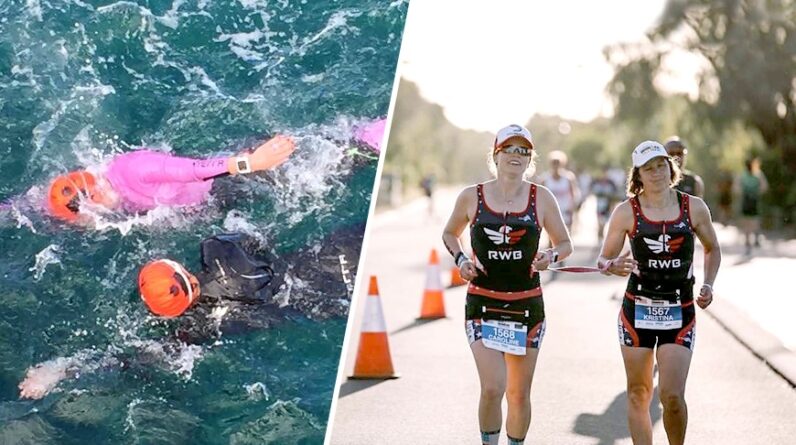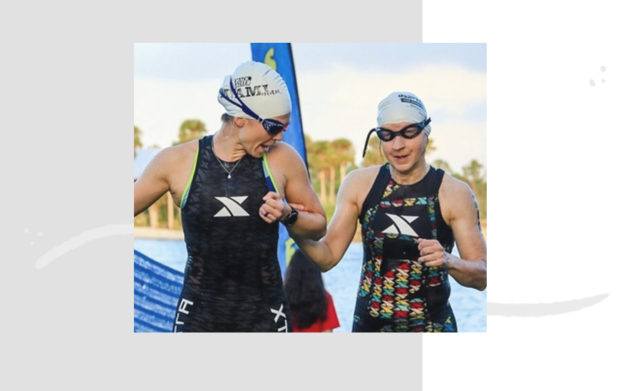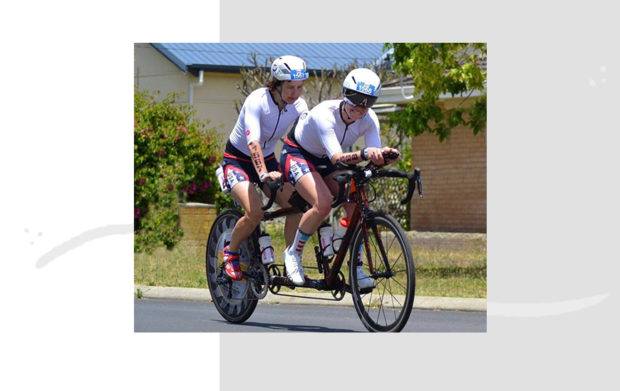
Ament’s effort paid off—Team Sea to See ended up becoming the first team with all blind stokers to complete the grueling race, finishing in an impressive 7 days, 15 hours, and 3 minutes. And while for many athletes, this would be a singularly impressive lifetime achievement, it was just one in a long line of victories for Gaynor and Ament. The pair has been competing in endurance races together since 2010, with Gaynor acting as Ament’s guide for about 20 events total, including four Ironman triathlons. (You know, the race that involves a 2.4 mile swim, 112-mile bike ride, and full 26.2-mile marathon. No biggie.)
The pair has been competing in endurance races together since 2010, with Gaynor acting as Ament’s guide for about 20 events total, including four Ironman triathlons.
The women met by chance at the starting line of the New York City triathlon in 2010—it was Ament’s first tri ever, and both she and Gaynor were competing with other partners at the time. Gaynor, 35, had been racing in triathlons since high school, whereas Ament, 57, found the sport after years as a competitive rower and marathon runner. “My sister’s blind as well, and my parents were always like, ‘You need to find a way to stay active, because it’s not good to be sedentary,'” says Ament, a U.S. Department of Justice lawyer who grew up skiing, horseback riding, and swimming. “I sort of took that to a whole other level.” After that first race, she decided she wanted to sign up for the 2010 Chicago triathlon, and she gave Gaynor, a Chicago native, a call.
Back then, there weren’t many blind-and-sighted duos on the endurance racing scene, but the number has been steadily growing in recent years. Dare to Tri, a Chicago-based nonprofit that trains disabled and visually impaired people to compete in triathlons, now works with hundreds of athletes annually—when it launched in 2011, there were around 25 people on its roster.
What’s it like to guide a blind athlete?
As Gaynor puts it, her job is to act as Ament’s eyes during a race, helping her dodge obstacles and keeping her safe while running, cycling, and swimming. “With a blind runner, it’s pretty straightforward—you’re tethered to the athlete the entire time, either at the waist or the wrist,” she explains. “The main job of the guide is to keep the athlete from running into or tripping over things, but we all make mistakes. I’ve definitely caused Tina to face-plant a few times, which is unfortunate but she’s very forgiving.”
The guide should ideally be faster and stronger than the person they’re leading. But that’s hard to find when an accomplished athlete like Ament is involved.
When cycling, the pair share a tandem bike, with Gaynor steering, shifting, and braking up front and Ament providing pedal power in the back. And while swimming, the athletes are tethered together at the waist or the thigh. “During a [triathlon] swim, Caroline needs to run interference on other athletes, since people try to swim between you,” says Ament. Gaynor adds that this is usually unintentional—it’s hard to see a tether underwater—but she does have to be aggressive sometimes to keep other swimmers from clotheslining themselves on the tether or pulling it loose entirely. “My priority is making sure Tina’s safe and that we’re continuing to move forward,” she says.
As you can imagine, there are some challenges involved with this kind of relationship. For one thing, the guide should ideally be faster and stronger than the person they’re leading—otherwise, the guide could hold the athlete back from getting their best time. But that’s hard to find when an accomplished athlete like Ament is involved. “It’s not necessarily easy for me to find someone who’s faster than me at both the run and the swim,” she says. Although both she and Gaynor have other racing and training partners, their ultra-compatibility is part of the reason why they’ve continued competing together for so long, even though they live in different states.
“There’s a reason why I’ve been consistently guiding for 11 years now. It’s just better with a buddy.”
Gaynor and Ament have also seen their communication styles evolve over the course of their relationship. I’m always trying to be conscious of the fact that it’s Tina’s race, and it’s been about learning what’s going to motivate her, not motivate her—or if she even needs to be motivated,” says Gaynor. Although they’ve grown so close that this isn’t really an issue anymore, Ament points out that Gaynor still helps pull her out of negative thought loops during races. That kind of support is rare in individual sports like running and cycling, and Gaynor says it’s why she loves her side gig so much. “There’s a reason why I’ve been consistently guiding for 11 years now. It’s just better with a buddy.”
How to serve as a guide for a blind runner—or find a sighted guide to help you explore a new sport.
The main thing Gaynor and Ament want people to know about guiding is that it doesn’t matter how accomplished or athletic you are. “There’s a role for every single person who wants to guide, whether it’s holding a guide dog at the start [of a race], going out and doing a run or walk with someone who’s never been on the trail before, or racing with someone who wants to make the Paralympics,” Ament says. She points out that guides are needed for all kinds of sports, from downhill and cross country skiing to climbing, hiking, and horseback riding. “If someone wants to get involved with helping blind people to do sports, there are more than enough places for them to do it and they don’t have to be a super Olympian.”
There are several organizations that connect blind runners and other athletes with guides, including Achilles International, United in Stride, and Catapult. “Currently there’s no certification. You just have to listen to the athlete,” says Gaynor. “Never make assumptions about what people are or aren’t capable of. Ask lots of questions and find out what they need. That’s really the way to become a guide.”
“Never make assumptions about what people are or aren’t capable of.”
Ultimately, says Gaynor, that decision was one of the best ones she’s ever made—she now considers Ament to be like a member of her family, one who’s helped guide her through some of the best and hardest times in her life. And Ament is equally grateful that Gaynor took a chance on her passion. “Without my guides, my life would be much, much more narrow,” she says. “I would probably still do four- and six-hour bike rides, but they’d probably be on a trainer watching Netflix. And honestly, there are better ways to spend your Saturday.” Like traversing the United States on two wheels and swimming around the world’s largest wooden jetty in Australia to a cheering crowd during a recent Ironman—all with one of her best friends by her side.
Inspired to up your distance-running game? Here’s a 20-week training plan for first-time marathoners—and if you’ve been there and done that, consider making an ultra-marathon your next fitness goal.









